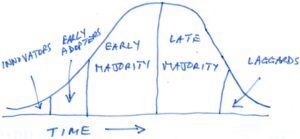What is Innovation Diffusion?
You may be familiar with the idea of Innovation Diffusion and the diagram below. In this post I’ll explain what it is about and ask how it applies to small enterprises.
 The diagram shows how people take up new products or services. Time flows from left to right. Where a product takes off, the curve shows how people take up the offer. This pattern is particularly helpful where there is a large potential market and the product becomes popular.
The diagram shows how people take up new products or services. Time flows from left to right. Where a product takes off, the curve shows how people take up the offer. This pattern is particularly helpful where there is a large potential market and the product becomes popular.
Testing the product or service takes place among a few innovators, who enjoy trying out new ideas. They are not too worried about investing in something that might not work. Early adopters take up an improved product and feed back more information. The big step is moving to the early majority. A product that breaks through to its potential market sees rapid growth in sales as the product becomes fashionable. As sales increase, they will inevitably pass a point where sales start to decline and these are the late majority. The laggards are people in the market for the product who are not interested or choose to delay purchase for some reason.
The thing to note is this is the typical life cycle of a successful product. There is no guarantee an innovation will follow this pattern. Most innovations fizzle out in the innovators or early adopters stages. Why? The reasons are complex but quality of product is no guarantee of success.
Innovation Diffusion and the Small Business
To what extent is this model helpful to the small entrepreneur who has a new idea and sets out to sell it? A big, established company can pay innovators to test their product in return for testimonials and other publicity. This is an option open to a small entrepreneur but many may not able to give it away to many people. Also fear that it may be copied and promoted more efficiently by a more established player, may inhibit those early stages.
Another issue for small businesses is the size of their market. Successful products may have a huge potential market and for small businesses, servicing a niche or local market, building up a head a steam as implied by the central part of the curve may be difficult. This is not to say that a business in this situation is necessarily doomed to being unsuccessful. If it can communicate with its market, it may be possible to generate enough sales.
So, for the small business the issues are the size of their potential market and how effective they are at reaching it. Next Friday, I shall review a few questions entrepreneurs can ask, when marketing a new idea to a limited potential market.
Have you seen this model before and how helpful do you find it?